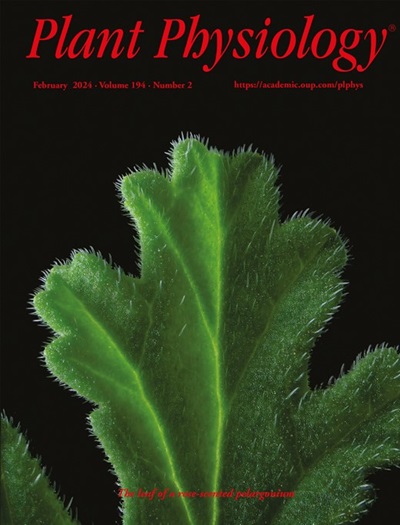The trehalose 6-phosphate pathway coordinates dynamic changes at the shoot apical meristem in Arabidopsis thaliana
IF 6.5
1区 生物学
Q1 PLANT SCIENCES
引用次数: 0
Abstract
A plant’s stem cell population in the shoot apical meristem (SAM) is maintained by WUSCHEL (WUS) and CLAVATA3 (CLV3). SAM size is dynamic and undergoes a more than 2-fold expansion upon transition to reproductive growth. The mechanism controlling this doming is largely unknown; however, coinciding increased trehalose 6-phosphate (T6P) levels suggest a participation of the T6P pathway in Arabidopsis (Arabidopsis thaliana). Moreover, lines misexpressing or with reduced expression of TREHALOSE PHOSPHATE SYNTHASE1 (TPS1) have smaller and larger SAMs, respectively. Here, we show that TREHALOSE PHOSPHATE PHOSPHATASEJ (TPPJ) is directly regulated by WUS. Changing TPPJ transcript levels in the outer layer affects SAM size and flowering time, and its reduction in the late-flowering clv3 mutant restores wild-type flowering. This is associated with altered mature miR156 abundance and expression of the SQUAMOSA PROMOTER-BINDING PROTEIN-LIKE genes SPL3, SPL4, SPL5, and SPL9. Furthermore, SPL4 is controlled by WUS, whilst SPL4 directly represses WUS, establishing negative feedback regulation. This feedback loop is important for age pathway-induced flowering involving the T6P pathway and suggests dynamic feedback regulations between central meristem maintenance and flowering time regulators with sugar signaling throughout development.海藻糖6-磷酸途径协调拟南芥茎尖分生组织的动态变化
植物茎尖分生组织(SAM)中的干细胞群体由WUSCHEL (WUS)和CLAVATA3 (CLV3)维持。SAM的大小是动态的,在向生殖生长过渡时经历了2倍以上的扩张。控制这种穹顶的机制在很大程度上是未知的;然而,同时升高的海藻糖6-磷酸(T6P)水平表明,T6P途径参与了拟南芥(拟南芥)。此外,错误表达或减少表达海藻糖磷酸合酶1 (TREHALOSE PHOSPHATE SYNTHASE1, TPS1)的细胞系,其sam分别更小和更大。在这里,我们发现海藻糖磷酸磷酸酶(TPPJ)是由WUS直接调控的。外层TPPJ转录物水平的改变会影响SAM的大小和开花时间,在晚花期clv3突变体中,TPPJ转录物水平的降低恢复了野生型开花。这与成熟miR156丰度的改变和SQUAMOSA启动子结合蛋白样基因SPL3、SPL4、SPL5和SPL9的表达有关。SPL4受WUS控制,SPL4直接抑制WUS,形成负反馈调控。这一反馈回路对于涉及T6P通路的年龄通路诱导的开花很重要,并表明在整个发育过程中,糖信号在中心分生组织维持和开花时间调节之间存在动态反馈调节。
本文章由计算机程序翻译,如有差异,请以英文原文为准。
求助全文
约1分钟内获得全文
求助全文
来源期刊

Plant Physiology
生物-植物科学
CiteScore
12.20
自引率
5.40%
发文量
535
审稿时长
2.3 months
期刊介绍:
Plant Physiology® is a distinguished and highly respected journal with a rich history dating back to its establishment in 1926. It stands as a leading international publication in the field of plant biology, covering a comprehensive range of topics from the molecular and structural aspects of plant life to systems biology and ecophysiology. Recognized as the most highly cited journal in plant sciences, Plant Physiology® is a testament to its commitment to excellence and the dissemination of groundbreaking research.
As the official publication of the American Society of Plant Biologists, Plant Physiology® upholds rigorous peer-review standards, ensuring that the scientific community receives the highest quality research. The journal releases 12 issues annually, providing a steady stream of new findings and insights to its readership.
 求助内容:
求助内容: 应助结果提醒方式:
应助结果提醒方式:


